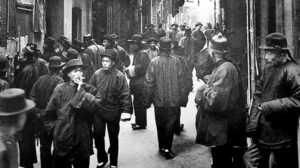
Credit: Arnold Genthe, The Street of Gamblers (Ross Alley) 1898, Gelatin silver print. Fine Arts Museums of San
Francisco
After the Texas War of Independence ended in 1836, tensions between the U.S. and Mexico increased. Before gaining independence, Texas had been a refuge for runaways but eventually became a slave state. The concept of “Manifest Destiny”the idea that the U.S. had the divinely granted right tr expand geographically from Atlantic to Pacific–was well-entrenched by the time James K. Polk became President in 1845; indeed, he had run on an aggressive expansionist platform. The fact that most of the Mexican territories were already inhabited was largely ignored. Many believed that the Protestant, English-speaking Americans were better equipped to govern the Mexican territories than American Indians or Catholic, Spanish-speaking Mexicans. In 1835 and 1845, the United States tried to purchase New Mexico and California from Mexico. But the Mexican government refused. From 1846-1848 the U.S. fought the Mexican-American War, eventually acquiring the territories of California and New Mexico.
- In 1845, Texas was admitted to the Union as the 28th state.
- The California Gold Rush began in January 1848 when carpenter James Marshall discovered gold at John Sutter’s lumber mill on the American River at Coloma. As news spread of the discovery, the ensuing gold rush led to an influx of hundreds of thousands of immigrants from every corner of the world.
- In 1849, Henry Thoreau published Civil Disobedience, which recounted his refusal to pay his poll tax in protesting the Mexican War.
- In 1850, the California territory became a state of the Union. The gold mining frenzy had stripped the land of its natural resources. Robbed of their natural food sources, California’s Indians raided mining towns and white settlements for food, setting off a chain reaction of brutal retaliation. The California legislature then passed the subsequent Indenture Act which gave whites the authorization to legally enslave Native peoples and their children, resulting in widespread kidnapping of Indian children, who were then sold into slaveryan extreme form of human oppression whereby an individual may "own" another person and the... More.
- In 1853, California began confining its remaining Indian population on military reservations, after near genocide and legal enslavement legislation. Prior to 1849, some 150,000 Indians lived in the state, but by 1870, less than 30,000 remained.
- In 1854, John Rollin Ridge published The Life and Adventures of Joaquin Murieta, the Celebrated Bandit, widely considered the first novel written by a Native American. A fictionalized version of a notorious bandit’s real-life story (and the inspiration for Zorro tales), the novel condemned white racial bias against Mexicans. John Rollin Ridge was the son and grandson of Cherokee leaders John Ridge and Major Ridge, who signed a treaty that surrendered Cherokee lands east of the Mississippi River and eventually led to the Trail of Tears. As a boy, Ridge witnessed his father’s and grandfather’s murders by Cherokees opposed to the treaty. Ridge and his white mother fled to Fayetteville, Arkansas, and later Massachusetts, where he was educated. He later returned to Arkansas to practice law. In 1849, Ridge murdered a man thought to be involved in his father’s murder, and then fled to Missouri and California during the Gold Rush. Despite his Native heritage, Ridge owned slaves while in Arkansas, and believed California Indians to be inferior to other tribes. Ridge supported slavery, opposing both Abraham Lincoln and the Emancipationfreedom from legalized slavery gained by most enslaved persons of African descent immediately following the... More Proclamation.

Source: Wikipedia, Credit: Latin American Studies.org, Filibusters
“… that claim is by the right of our manifest destiny to overspread and to possess the whole of the continent which Providence has given us for the development of the great experiment of liberty and federated self-government entrusted to us.”
– John Louis O’Sullivan, as published in a New York Morning News column
John Louis O’Sullivan was the founder and editor of the Democratic Review, a literary magazine that published Ralph Waldo Emerson, Henry David Thoreau, Walt Whitman and Nathaniel Hawthorne. Active in New York politics early in his career, O’Sullivan advocated abolishing the death penalty and promoted reform of New York City public schools, as well as rights for women and working people. Years later he became a staunch defender of slavery and while in Europe, supported the Confederacy during the Civil War. Many believe he was on their payroll. He returned to the U.S. in the late 1870s, but was unsuccessful in reviving his political career. O’Sullivan is credited with coining the phrase “Manifest Destiny” in an 1845 essay published in the Democratic Review.




